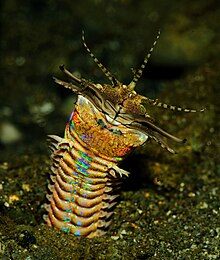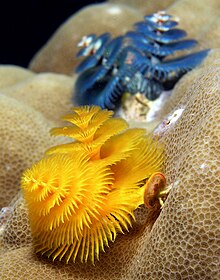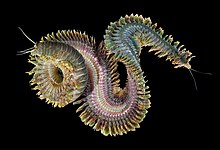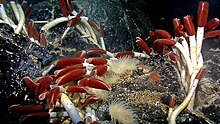Polychaete
| Polychaetes Temporal range:
| |
|---|---|

| |
| "A variety of marine worms": plate fromDas MeerbyM. J. Schleiden(1804–1881) | |
| Scientific classification | |
| Domain: | Eukaryota |
| Kingdom: | Animalia |
| Phylum: | Annelida |
| Class: | Polychaeta Grube, 1850 |
| Groups included | |
| Cladisticallyincluded but traditionally excluded taxa | |
Polychaeta(/ˌpɒlɪˈkiːtə/) is aparaphyletic[1]class of generally marineannelid worms,commonly calledbristle wormsorpolychaetes(/ˈpɒlɪˌkiːts/). Each body segment has a pair of fleshy protrusions calledparapodiathat bear many bristles, calledchaetae,which are made ofchitin.More than 10,000 species are described in this class. Common representatives include thelugworm(Arenicola marina) and thesandwormorclam wormAlitta.
Polychaetes as a class are robust and widespread, with species that live in the coldest ocean temperatures of theabyssal plain,to forms which tolerate the extremely high temperatures nearhydrothermal vents.Polychaetes occur throughout the Earth's oceans at all depths, from forms that live asplanktonnear the surface, to a 2- to 3-cm specimen (still unclassified) observed by the robot ocean probeNereusat the bottom of theChallenger Deep,the deepest known spot in the Earth's oceans.[2]Only 168 species (less than 2% of all polychaetes) are known from fresh waters.[3]
Description
[edit]Polychaetes are segmented worms, generally less than 10 cm (4 in) in length, although ranging at the extremes from 1 mm (0.04 in) to 3 m (10 ft), inEunice aphroditois.They can sometimes be brightly coloured, and may beiridescentor evenluminescent.Each segment bears a pair of paddle-like and highly vascularizedparapodia,which are used for movement and, in many species, act as the worm's primaryrespiratorysurfaces. Bundles of bristles, calledchaetae,project from the parapodia.[4]
However, polychaetes vary widely from this generalized pattern, and can display a range of different body forms. The most generalised polychaetes are those that crawl along the bottom, but others have adapted to many differentecological niches,including burrowing, swimming,pelagiclife, tube-dwelling or boring,commensalism,andparasitism,requiring various modifications to their body structures.
The head, orprostomium,is relatively well developed, compared with other annelids. It projects forward over the mouth, which therefore lies on the animal's underside. The head normally includes two to four pair of eyes, although some species are blind. These are typically fairly simple structures, capable of distinguishing only light and dark, although some species have large eyes with lenses that may be capable of more sophisticated vision,[4]including the Alciopids' complex eyes which rival cephalopod and vertebrate eyes.[5][6]
Many species showbioluminescence;eight families have luminous species.[7][8]
The head also includes a pair ofantennae,tentacle-likepalps,and a pair of pits lined withcilia,known as "nuchal organs". These latter appear to bechemoreceptors,and help the worm to seek out food.[4]
Internal anatomy and physiology
[edit]

The outer surface of the body wall consists of a simplecolumnar epitheliumcovered by a thincuticle.Underneath this, in order, are a thin layer of connective tissue, a layer of circular muscle, a layer of longitudinal muscle, and aperitoneumsurrounding thebody cavity.Additional oblique muscles move the parapodia. In most species the body cavity is divided into separate compartments by sheets of peritoneum between each segment, but in some species it is more continuous.
The mouth of polychaetes is located on theperistomium,the segment behind theprostomium,and varies in form depending on their diets, since the group includes predators, herbivores, filter feeders, scavengers, and parasites. In general, however, they possess a pair of jaws and apharynxthat can be rapidly everted, allowing the worms to grab food and pull it into their mouths. In some species, the pharynx is modified into a lengthyproboscis.The digestive tract is a simple tube, usually with a stomach part way along.
The smallest species, and those adapted to burrowing, lackgills,breathing only through their body surfaces. Most other species have external gills, often associated with the parapodia.
A simple but well-developed circulatory system is usually present. The two main blood vessels furnish smaller vessels to supply the parapodia and the gut. Blood flows forward in the dorsal vessel, above the gut, and returns down the body in the ventral vessel, beneath the gut. The blood vessels themselves are contractile, helping to push the blood along, so most species have no need of a heart. In a few cases, however, muscular pumps analogous to a heart are found in various parts of the system. Conversely, some species have little or no circulatory system at all, transporting oxygen in thecoelomic fluidthat fills their body cavities.[4]
The blood may be colourless, or have any of three different respiratory pigments. The most common of these ishaemoglobin,but some groups havehaemerythrinor the green-colouredchlorocruorin,instead.
The nervous system consists of a single or double ventral nerve cord running the length of the body, withgangliaand a series of small nerves in each segment. The brain is relatively large, compared with that of other annelids, and lies in the upper part of the head. Anendocrine glandis attached to the ventral posterior surface of the brain, and appears to be involved in reproductive activity. In addition to the sensory organs on the head, photosensitive eye spots,statocysts,and numerous additional sensory nerve endings, most likely involved with the sense of touch, also occur on the body.[4]
Polychaetes have a varying number ofprotonephridiaormetanephridiafor excreting waste, which in some cases can be relatively complex in structure. The body also contains greenish "chloragogen"tissue, similar to that found inoligochaetes,which appears to function in metabolism, in a similar fashion to that of the vertebrateliver.[4]
The cuticle is constructed from cross-linked fibres ofcollagenand may be 200 nm to 13 mm thick. Their jaws are formed fromsclerotisedcollagen, and theirsetaefrom sclerotisedchitin.[9]
Ecology
[edit]



Polychaetes are predominantly marine, but many species also live in freshwater, and a few in terrestrial environments.[10]They are extremely variable in both form and lifestyle, and include a few taxa that swim among theplanktonor above theabyssal plain.Most burrow or build tubes in the sediment, and some live ascommensals.A few species, roughly 80 (less than 0.5% of species), are parasitic.[11][12]These include bothectoparasitesandendoparasites.Ectoparasitic polychaetes feed on skin, blood, and other secretions, and some are adapted to bore through hard, usually calcerous surfaces, such as the shells of mollusks.[12]These "boring" polychaetes may be parasitic, but may be opportunistic or even obligate symbionts (commensals).[13][12][11]
The mobile forms (Errantia) tend to have well-developed sense organs and jaws, while the stationary forms (Sedentaria) lack them, but may have specialized gills or tentacles used for respiration and deposit or filter feeding, e.g.,fanworms. Underwater polychaetes have eversible mouthparts used to capture prey.[14][self-published source?]A few groups have evolved to live in terrestrial environments, likeNamanereidinaewith many terrestrial species, but are restricted to humid areas. Some have even evolved cutaneous invaginations for aerial gas exchange.
Notable polychaetes
[edit]- One notable polychaete, thePompeii worm(Alvinella pompejana), is endemic to thehydrothermal ventsof the Pacific Ocean. Pompeii worms are among the most heat-tolerant complex animals known.
- A recently discovered genus,Osedax,includes a species nicknamed the "bone-eating snot flower".[15]
- Another remarkable polychaete isHesiocaeca methanicola,which lives onmethane clathratedeposits.
- Lamellibrachia luymesiis acold seeptube wormthat reaches lengths of over 3 m and may be the most long-lived animal, being over 250 years old.
- A still unclassified multilegged predatory polychaete worm was identified only by observation from the underwater vehicleNereusat the bottom of theChallenger Deep,the greatest depth in the oceans, near 10,902 m (35,768 ft) in depth. It was about an inch long visually, but the probe failed to capture it, so it could not be studied in detail.[16]
- The Bobbit worm (Eunice aphroditois) is a predatory species that can achieve a length at 3 m (10 ft)), with an average diameter of 25 mm (1 in).
- Dimorphilus gyrociliatushas the smallest known genome of any annelid. The species shows extremesexual dimorphism.Females measure ~1 mm long and have simplified bodies containing six segments, a reduced coelom, and no appendages, parapodia, or chaetae. The males are only 50 μm long and consist of just a few hundred cells. They lack a digestive system and have just 68 neurons, and only live for roughly a week.[17][18]
Reproduction
[edit]Most polychaetes have separate sexes, rather than being hermaphroditic. The most primitive species have a pair ofgonadsin every segment, but most species exhibit some degree of specialisation. The gonads shed immaturegametesdirectly into the body cavity, where they complete their development. Once mature, the gametes are shed into the surrounding water through ducts or openings that vary between species, or in some cases by the complete rupture of the body wall (and subsequent death of the adult). A few speciescopulate,but most fertilize their eggs externally.
The fertilized eggs typically hatch intotrochophorelarvae, which float among theplankton,and eventuallymetamorphoseinto the adult form by adding segments. A few species have no larval form, with the egg hatching into a form resembling the adult, and in many that do have larvae, the trochophore never feeds, surviving off the yolk that remains from the egg.[4]
However, some polychaetes exhibit remarkable reproductive strategies. Some species reproduce byepitoky.For much of the year, these worms look like any other burrow-dwelling polychaete, but as the breeding season approaches, the worm undergoes a remarkable transformation as new, specialized segments begin to grow from its rear end until the worm can be clearly divided into two halves. The front half, the atoke, is asexual. The new rear half, responsible for breeding, is known as the epitoke. Each of the epitoke segments is packed with eggs and sperm and features a single eyespot on its surface. The beginning of the last lunar quarter is the cue for these animals to breed, and the epitokes break free from the atokes and float to the surface. The eye spots sense when the epitoke reaches the surface and the segments from millions of worms burst, releasing their eggs and sperm into the water.[19]
A similar strategy is employed by the deep sea wormSyllis ramosa,which lives inside asponge.The rear ends of the worm develop into "stolons" containing the eggs or sperm; these stolons then become detached from the parent worm and rise to the sea surface, where fertilisation takes place.[20]
Fossil record
[edit]Stem-grouppolychaete fossils are known from theSirius PassetLagerstätte,a rich, sedimentary deposit in Greenland tentatively dated to the lateAtdabanian(earlyCambrian). The oldest found isPhragmochaeta canicularis.[21]Many of the more famousBurgess Shaleorganisms, such asCanadia,may also have polychaete affinities.Wiwaxia,long interpreted as an annelid,[22]is now considered to represent a mollusc.[23][24]An even older fossil,Cloudina,dates to the terminalEdiacaranperiod; this has been interpreted as an early polychaete, although consensus is absent.[25][26]
Beingsoft-bodied organisms,the fossil record of polychaetes is dominated by their fossilized jaws, known asscolecodonts,and themineralizedtubes that some of them secrete.[27]Most importantbiomineralising polychaetesareserpulids,sabellids,andcirratulids.Polychaete cuticle does have somepreservation potential;it tends to survive for at least 30 days after a polychaete's death.[9]Although biomineralisation is usually necessary to preserve soft tissue after this time, the presence of polychaete muscle in the nonmineralised Burgess shale shows this need not always be the case.[9]Their preservation potential is similar to that ofjellyfish.[9]
Taxonomy and systematics
[edit]






Taxonomically, polychaetes are thought to beparaphyletic,[28]meaning the group excludes some descendants of its most recent common ancestor. Groups that may be descended from the polychaetes include theclitellates(earthwormsandleeches),sipunculans,andechiurans.The Pogonophora andVestimentiferawere once considered separate phyla, but are now classified in the polychaete familySiboglinidae.
Much of the classification below matches Rouse & Fauchald, 1998, although that paper does not apply ranks above family.
Older classifications recognize many more (sub)orders than the layout presented here. As comparatively few polychaetetaxahave been subject tocladisticanalysis, some groups which are usually considered invalid today may eventually be reinstated.
These divisions were shown to be mostly paraphyletic in recent years.
- Basalorincertae sedis
- FamilyDiurodrilidae
- FamilyHistriobdellidae
- FamilyNerillidae
- FamilyParergodrilidae
- FamilyPotamodrilidae
- FamilyPsammodrilidae
- FamilySpintheridae
- FamilyProtodriloididae
- FamilySaccocirridae
- OrderHaplodrili
- OrderMyzostomida
- FamilyEndomyzostomatidae
- FamilyAsteromyzostomatidae
- FamilyMyzostomatidae
- SubclassPalpata
- FamilyProtodrilidae
- FamilyPolygordiidae
- SubclassAciculata
- FamilyLevidoridae
- OrderAmphinomida
- FamilyAmphinomidae
- FamilyEuphrosinidae
- OrderEunicida
- FamilyDorvilleidae
- FamilyEunicidae
- FamilyHartmaniellidae
- FamilyIchthyotomidae
- FamilyLumbrineridae
- FamilyOenonidae
- FamilyOnuphidae
- OrderPhyllodocida
- SuborderAphroditiformia
- FamilyAcoetidae
- FamilyAphroditidae
- FamilyEulepethidae
- FamilyIphionidae
- FamilyPholoidae
- FamilyPolynoidae
- FamilySigalionidae
- SuborderGlyceriformia
- FamilyGlyceridae
- FamilyGoniadidae
- FamilyLacydoniidae
- FamilyParalacydoniidae
- SuborderNereidiformia
- FamilyAntonbruunidae
- FamilyChrysopetalidae
- FamilyHesionidae
- FamilyNereididae
- FamilyPilargidae
- FamilySyllidae
- SuborderPhyllodocida incertae sedis
- FamilyIospilidae
- FamilyNautiliniellidae
- FamilyNephtyidae
- FamilyTyphloscolecidae
- FamilyTomopteridae
- SuborderPhyllodociformia
- FamilyAlciopidae
- FamilyLopadorrhynchidae
- FamilyPhyllodocidae
- FamilyPontodoridae
- SuborderAphroditiformia
- SubclassSedentaria
- FamilyChaetopteridae
- InfraclassCanalipalpata
- OrderSabellida
- FamilyCaobangidae
- FamilyFabriciidae
- FamilyOweniidae
- FamilySabellariidae
- FamilySabellidae
- FamilySerpulidae
- FamilySiboglinidae(formerly the phyla Pogonophora & Vestimentifera)
- OrderSpionida
- SuborderSpioniformia
- FamilyApistobranchidae
- FamilyLongosomatidae
- FamilyMagelonidae
- FamilyPoecilochaetidae
- FamilySpionidae
- FamilyTrochochaetidae
- FamilyUncispionidae
- SuborderSpioniformia
- OrderTerebellida
- SuborderCirratuliformia
- FamilyAcrocirridae(sometimes placed in Spionida)
- FamilyCirratulidae(sometimes placed in Spionida)
- FamilyCtenodrilidae(sometimes own suborder Ctenodrilida)
- FamilyFauveliopsidae(sometimes own suborder Fauveliopsida)
- FamilyFlabelligeridae(sometimes suborder Flabelligerida)
- FamilyFlotidae(sometimes included in Flabelligeridae)
- FamilyPoeobiidae(sometimes own suborder Poeobiida or included in Flabelligerida)
- FamilySternaspidae(sometimes own suborder Sternaspida)
- SuborderTerebellomorpha
- FamilyAlvinellidae
- FamilyAmpharetidae
- FamilyPectinariidae
- FamilyTerebellidae
- FamilyTrichobranchidae
- SuborderCirratuliformia
- OrderSabellida
- InfraclassScolecida
- FamilyArenicolidae
- FamilyCapitellidae
- FamilyCossuridae
- FamilyMaldanidae
- FamilyOpheliidae
- FamilyOrbiniidae
- FamilyParaonidae
- FamilyScalibregmatidae
- OrderCapitellida(nomen dubium)
- OrderCossurida(nomen dubium)
- OrderOpheliida(nomen dubium)
- OrderOrbiniida(nomen dubium)
- OrderQuestida(nomen dubium)
- OrderScolecidaformia(nomen dubium)
- SubclassEchiura
- OrderBonelliida
- FamilyBonelliidae
- FamilyIkedidae
- OrderEchiurida
- FamilyEchiuridae
- FamilyThalassematidae
- FamilyUrechidae
- OrderBonelliida
See also
[edit]References
[edit]Bibliography
[edit]- Campbell, Reece, and Mitchell. Biology. 1999.
- Rouse, Greg W.; Fauchald, Kristian (1998)."Recent views on the status, delineation, and classification of the Annelida".American Zoologist.38(6): 953–964.doi:10.1093/icb/38.6.953.
Notes
[edit]- ^abStruck, T. H.; Paul, C.; Hill, N.; Hartmann, S.; Hösel, C.; Kube, M.; Lieb, B.; Meyer, A.; Tiedemann, R.; Purschke, G. N.; Bleidorn, C. (2011). "Phylogenomic analyses unravel annelid evolution".Nature.471(7336): 95–98.Bibcode:2011Natur.471...95S.doi:10.1038/nature09864.PMID21368831.S2CID4428998.
- ^Geography of GuamArchived1996-10-27 at theWayback Machinens.gov.gu Accessed Oct. 8, 2009
- ^Glasby, Cristopher; Timm, Tarmo (2008). E. V. Balian; C. Lévêque; H. Segers; K. Martens (eds.). "Global diversity of polychaetes (Polychaeta: Annelida) in freshwater".Hydrobiologia.595(1: Freshwater Animal Diversity Assessment): 107–115.CiteSeerX10.1.1.655.4467.doi:10.1007/s10750-007-9008-2.S2CID13143924.
- ^abcdefgBarnes, Robert D. (1982).Invertebrate Zoology.Philadelphia, PA: Holt-Saunders International. pp. 469–525.ISBN978-0-03-056747-6.
- ^High-resolution vision in pelagic polychaetes
- ^"14 Fun Facts About Marine Bristle Worms".
- ^Kanie, Shusei; Miura, Daisuke; Jimi, Naoto; Hayashi, Taro; Nakamura, Koji; Sakata, Masahiko; Ogoh, Katsunori; Ohmiya, Yoshihiro; Mitani, Yasuo (2021-09-27)."Violet bioluminescent Polycirrus sp. (Annelida: Terebelliformia) discovered in the shallow coastal waters of the Noto Peninsula in Japan".Scientific Reports.11(1): 19097.Bibcode:2021NatSR..1119097K.doi:10.1038/s41598-021-98105-6.ISSN2045-2322.PMC8476577.PMID34580316.
- ^Zörner, S. A.; Fischer, A. (22 Dec 2006)."The spatial pattern of bioluminescent flashes in the polychaete Eusyllis blomstrandi (Annelida)".Helgoland Marine Research.61(1): 55–66.doi:10.1007/s10152-006-0053-4.ISSN1438-3888.S2CID2473677.
- ^abcdBriggs, Derek E. G.; Kear, Amanda J. (8 February 2016). "Decay and preservation of polychaetes: taphonomic thresholds in soft-bodied organisms".Paleobiology.19(1): 107–135.Bibcode:1993Pbio...19..107B.doi:10.1017/S0094837300012343.JSTOR2400774.S2CID84073818.
- ^Annelids in Extreme Aquatic Environments: Diversity, Adaptations and Evolution
- ^abMartin, Daniel; Nygren, Arne; Cruz-Rivera, Edwin (2017-06-01)."Proceraea exoryxae sp. nov. (Annelida, Syllidae, Autolytinae), the first known polychaete miner tunneling into the tunic of an ascidian".PeerJ.5:e3374.doi:10.7717/peerj.3374.ISSN2167-8359.PMC5457667.PMID28584710.
- ^abcMartin, Daniel; Britayev, Temir A. (1998)."SYMBIOTIC POLYCHAETES: REVIEW OF KNOWN SPECIES".Oceanography and Marine Biology: An Annual Review.CRC Press. pp. 225–254.doi:10.1201/b12646-22(inactive 31 January 2024).hdl:10261/39328.ISBN9780429210600.
{{cite book}}:CS1 maint: DOI inactive as of January 2024 (link) - ^Abe, Hirokazu; Hoshino, Osamu; Yamada, Kazuyuki; Ogino, Tetsuya; Kawaida, Shun; Sato-Okoshi, Waka (2022-06-28)."A novel symbiotic relationship between ascidians and a new tunic-boring polychaete (Annelida: Spionidae: Polydora)".Zootaxa.5159(1): 1–22.doi:10.11646/zootaxa.5159.1.1.ISSN1175-5334.PMID36095560.
- ^"Bristleworm".MESA.[self-published source]
- ^"'Zombie worms' found off Sweden ".BBC News.18 October 2005.Retrieved12 February2010.
- ^Accessed Oct. 8, 2009Archived1996-10-27 at theWayback MachineGeography of the ocean floor near Guam with some notes on exploration of the Challenger Deep.
- ^A tiny worm sheds light into genome compaction
- ^Martín-Durán, José M.; Vellutini, Bruno C.; Marlétaz, Ferdinand; Cetrangolo, Viviana; Cvetesic, Nevena; Thiel, Daniel; Henriet, Simon; Grau-Bové, Xavier; Carrillo-Baltodano, Allan M.; Gu, Wenjia; Kerbl, Alexandra; Marquez, Yamile; Bekkouche, Nicolas; Chourrout, Daniel; Gómez-Skarmeta, Jose Luis; Irimia, Manuel; Lenhard, Boris; Worsaae, Katrine; Hejnol, Andreas (2020)."Conservative route to genome compaction in a miniature annelid".Nature Ecology & Evolution.5(2): 231–242.Bibcode:2020NatEE...5..231M.doi:10.1038/s41559-020-01327-6.PMC7854359.PMID33199869.
- ^Piper, Ross(2007).Extraordinary Animals: An Encyclopedia of Curious and Unusual Animals.Greenwood Press.ISBN9780313339226.
- ^Frost, Emily; Waters, Hannah (1 July 2015)."Some polychaetes have sex lives out of a science fiction movie".14 fun facts about marine bristle worms.Smithsonian.com.Retrieved9 August2017.
- ^Conway Morris, S.; Peel, J. S. (2008)."The Earliest Annelids: Lower Cambrian Polychaetes from the Sirius Passet Lagerstätte, Peary Land, North Greenland".Acta Palaeontologica Polonica.53:137–148.doi:10.4202/app.2008.0110.
- ^Butterfield, N. J. (1990). "A reassessment of the enigmatic Burgess Shale fossilWiwaxia corrugata(Matthew) and its relationship to the polychaeteCanadia spinosaWalcott ".Paleobiology.16(3): 287–303.Bibcode:1990Pbio...16..287B.doi:10.1017/S0094837300010009.JSTOR2400789.S2CID88100863.
- ^Smith, M. R. (2012)."Mouthparts of the Burgess Shale fossilsOdontogriphusandWiwaxia:Implications for the ancestral molluscan radula ".Proceedings of the Royal Society B.279(1745): 4287–4295.doi:10.1098/rspb.2012.1577.PMC3441091.PMID22915671.
- ^Smith, M. R. (2014)."Ontogeny, morphology and taxonomy of the soft-bodied Cambrian 'mollusc'Wiwaxia".Palaeontology.57(1): 215–229.Bibcode:2014Palgy..57..215S.doi:10.1111/pala.12063.S2CID84616434.
- ^Miller, A. J. (2004).A revised morphology ofCloudinawith ecological and phylogenetic implications.CiteSeerX10.1.1.526.5035.
- ^Vinn, Olev; Zatoń, Michał (March 2012)."Inconsistencies in proposed annelid affinities of early biomineralized organismCloudina(Ediacaran): structural and ontogenetic evidences ".Carnets de Géologie(Lettres).doi:10.4267/2042/46095.
- ^Vinn, O; Mutvei, H (2009)."Calcareous tubeworms of the Phanerozoic".Estonian Journal of Earth Sciences.58(4): 286.doi:10.3176/earth.2009.4.07.
- ^Westheide, W. (1997). "The direction of evolution within the Polychaeta".Journal of Natural History.31(1): 1–15.Bibcode:1997JNatH..31....1W.doi:10.1080/00222939700770011.
External links
[edit]- World Polychaeta Database
- Special issue ofMarine Ecologydedicated to polychaetes
- Marine Polychaete Larva,a guide to the marine zooplankton of south eastern Australia
- Key to Families of Polychaetes,Natural History Museum
